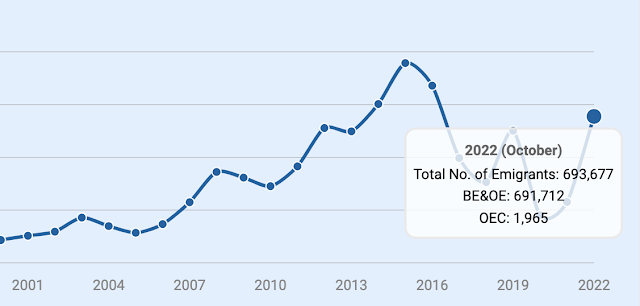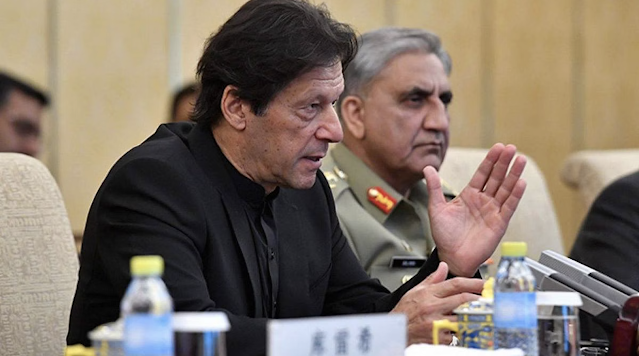Pakistan displayed its latest drones at IDEAS 2022 (International Defence Exhibition and Seminar) Defense Expo held in November in Karachi. It also presented sessions on artificial intelligence (AI), machine learning (ML) and connectivity. The event attracted more than 50 countries, including large pavilions set up by Pakistan's closest friends China and Turkey. The four-day IDEAS 2022 opened on November 15, 2022 at Karachi Expo Centre, bringing together 300 leading national and international defense manufacturers and over 300 foreign delegates from 57 countries.
 |
| Pakistan's Shahpar 2 Attack Drone |
Shahpar 2 Drone:
On display at IDEAS 2022 was Shahpar-2 Medium Altitude Long Endurance (MALE) attack drone produced by Global Industrial and Defense Solutions (GIDS), a Pakistani state-owned defense conglomerate. It can fly at a maximum speed of around 222 kilometers per hour (kph) with maximum range of around 1,050 kilometers, and the data link range of 300 kilometers. It can contact satellites in day or night operations.
Shahpar 2 drone can locate, surveil, track and attack targets. Its Zumr-II (EO/IR) turret is an improved and lighter version of Zumr-I (EP) turret. It can also be equipped with SAR, COMINT/ELINT payload. For sensors and targeting systems drone has an internal hard-point where it carry 50 kg (110 lb) payload. (Zumr-I weighs 36.5 kg (80 lb) while Zumr-II weighs 49 kg (108 lb)). The drone has two external hard-points where it can carry laser guided weapons, AGMs 60 kg (130 lb) each. Shapar 2 has already been inducted into service with Pakistan’s Army, Navy, and Air Force.
 |
| Pakistan Navy's Cruise Missiles: Babur, Harba and Zarb. Source: Quwa |
Also on display were advanced Harbah anti-ship cruise missiles made by Pakistan's state-owned Global Industrial and Defence Solutions (GIDS) and electronic warfare system produced by National Radio and Telecommunication Corporation (NRTC). The locally developed Al-Khalid tanks and modern assault rifles manufactured by Pakistan Ordinance Factories (POF) were also exhibited. Visitors also got a close look at the Pakistan Air Force (PAF) JF-17 Thunder fighter jets produced jointly by China and Pakistan.
JF-17 Block III:
JF-Block-III is a BVR (Beyond Visual Range) multi-role fighter jet capable of firing long range air-to-air missiles like China's PL-10 and PL-15. It features active electronically scanned array (AESA) radar system, making it Pakistan Air Force’s first AESA-equipped fighter aircraft. Combination of AESA radar and 120-mile range PL-15 missiles make the JF-17 Block 3 an extremely lethal fighter for beyond visual range combat, considerably more capable than any fighter in Pakistani service including the F-16. It also has a new electronic warfare system, upgraded avionics including a three-axis fly-by-wire digital flight control system, and a helmet-mounted display and sight (HMDS) system. With its new integrated sensor package, the aircraft will have the capability for quick information sharing and network-enabled operations that facilitate earlier detection and interception of enemy aircraft.
 |
| Pakistan JF-17 Block 3 Fighter Jet |
Chinese and Turkish Pavilions:
Pakistan’s longtime allies China and Turkey had the largest foreign presence at IDEAS 2022. Chinese state-run defense conglomerate China North Industries Group Corporation Limited (NORINCO) displayed missiles and weapon systems including the Red Arrow 9A anti-tank guided missile.
Turkey displayed a scale model of its fifth-generation fighter, codenamed the TF-X, at Pakistan’s IDEAS expo 2022. Over two dozen Turkish defense manufacturers participated in Pakistan’s IDEAS defense expo this year.
Top Turkish defense manufacturers, including Roketsan, state-run STM and ASFAT, showcased their products ranging from modern armed drones to tactical mini-UAV systems. Turkish Aerospace exhibited the models of the T129 ATAK helicopter, Gokbey multirole helicopter, Gokturk-2 observation satellite, as well as Anka unmanned aerial vehicle (UAV) and Aksungur medium-altitude long-range endurance (MALE) UAV.
AI and Connectivity:
Pakistan Air Force (PAF) launched a Cognitive Electronic Warfare (CEW) program in 2020 at its Center for Artificial Intelligence and Computing (CENTAIC). Modern connected weapon systems generate vast amounts of data requiring artificial intelligence and machine learning software for speedy analysis and rapid decision-making on the battlefield.
A seminar titled ‘Artificial Intelligence (AI) in Defence Market: A Paradigm Shift in Military Strategy and National Security’ was organized as part of IDEAS-22. Also discussed was ‘One Network’, an advanced communication project, under which 3,000 kilometers of underground fibre optic cable is being laid along the motorways in Pakistan.
An example of connectivity and integration was demonstrated in Operation Swift Retort against India in February 2019. The success of this operation was the result of combat-proven PAF fighters which are fully integrated with the air defense system (e.g. AWACS), and are mutually data-linked, alongside all AEW (Airborne Early Warning) and ground sensors.
Rethink After Ukraine War:
The war in Ukraine is forcing a defense strategy rethink in countries around the world. This is particularly true of countries such as India that rely mainly on Russian equipment and training. Hindustan Times has quoted an unnamed former Indian Army Chief as saying: “War videos available show that the Russian Army has tactical issues in Ukraine war. Tell me, which tank formation goes to war in a single file without air or infantry cover when the opponent is equipped with the best anti-tank guided missile like Javelin or Turkish Bayraktar TB2 missile firing drones? There is question on Russian air supremacy with Ukraine Army armed with shoulder fired Stinger surface to air missiles as well as the night fighting capability of the Russian Air Force.”
Related Links:
Haq's Musings
South Asia Investor Review
Pakistan-China Defense Industry Collaboration Irks West
Pakistan's Cyber Attack and Defense Capability
Is India a Paper Elephant?
Pakistan's Aircraft Exports
Pakistan Navy Modernization
West's Technological Edge in Geopolitical Competition
Pakistan Defense Industry
Silicon Valley Book Launch of "Eating Grass"
Ukraine's Lesson For Pakistan: Never Give Up Nukes!
Pakistan Economy Nears Trillion Dollars
Pakistan's Sea-Based Second Strike Capability
Riaz Haq Youtube Channel
VPOS Youtube Channel
















